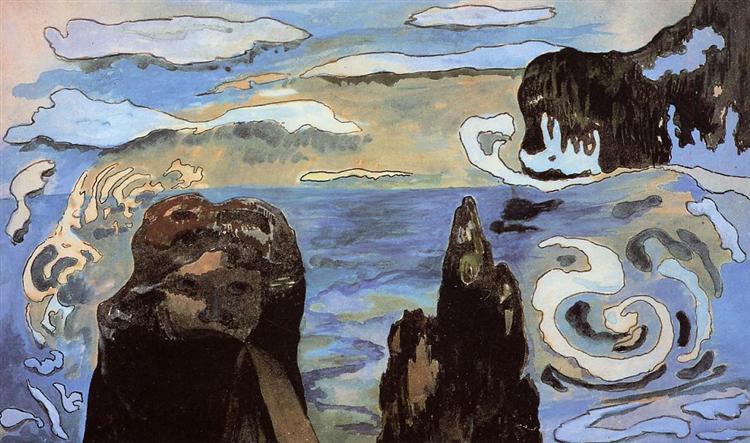Description
The painting "In the Black Rocks" (1889) by Paul Gauguin is a work that is inscribed in the context of postimpressionism, a movement characterized by its exploration of the color, shape and subjectivity of the artist. This oil on canvas presents a marine landscape in which the elements are intertwined through a vibrant color palette that challenges naturalistic representation. Gauguin, known for his search for the exotic and the symbolic, captures in this work the essence of his connection with nature and his desire to express something that goes beyond the mere visual appearance.
The composition of "on black rocks" focuses on a rocky environment, with a formidable black rock formation that rises in front of a sea that reflects a range of intense blue. The arrangement of the rocks in the foreground anchor the paint, while the horizon is blurred, suggesting the encounter between the sky and the sea. This use of space and structure could be interpreted as a representation of the contrast between the solidity of the rock, a symbol of permanence, and the ephemeral nature of the water.
Gauguin displays his mastery in color management through a combination of saturated tones that combine blue, green and ocher, which transmit not only a visual representation, but also an emotional experience. The snails and the foam of the sea are combined with a sky full of nuances, creating an atmosphere in which the color becomes the true protagonist of the visual narrative. In this sense, Gauguin moves away from the faithful representation to experiment with a form of symbolism that becomes an expression of his internal and spiritual world.
The landscape lacks human figures, a decision that, although it is common in Gauguin's work, in this work reinforces a sense of isolation and contemplation against the immensity of nature. The rocks and the sea are the only inhabitants of this environment, which invites the viewer to contemplative meditation on the relationship between the human being and the natural world. The elimination of the human figure can be interpreted as a search for the purity of aesthetic experience, emphasizing the spiritual connection of the artist with the surrounding nature.
When exploring the history of the work, it is important to consider the context of its creation. This is located during the second stage of Gauguin's career, a period in which he was deeply influenced by his trips to Tahiti, although "in the black rocks" she was painted in Brittany, France. This environment was fundamental for Gauguin, since it allowed him to experiment with issues of isolation and spirituality, elements that are in his work recurrently.
The work reflects Gauguin's interest in transcending impressionism, looking for a style that evokes emotion and the search for inner truth. In this sense, "in the black rocks" it is not only a testimony of its technical ability and its adventurous color use, but also a visual record of its introspection and its connection with the western landscape at the end of the 19th century. Gauguin, through this work, continues to invite the viewer to contemplate and reflect on the deep layers of meaning that hide behind the apparent simplicity of a marine landscape.
KUADROS ©, a famous paint on your wall.
Hand-made oil painting reproductions, with the quality of professional artists and the distinctive seal of KUADROS ©.
Reproduction service paintings With a guarantee of satisfaction. If you are not completely satisfied with the replica of your painting, we refund your money 100%.

